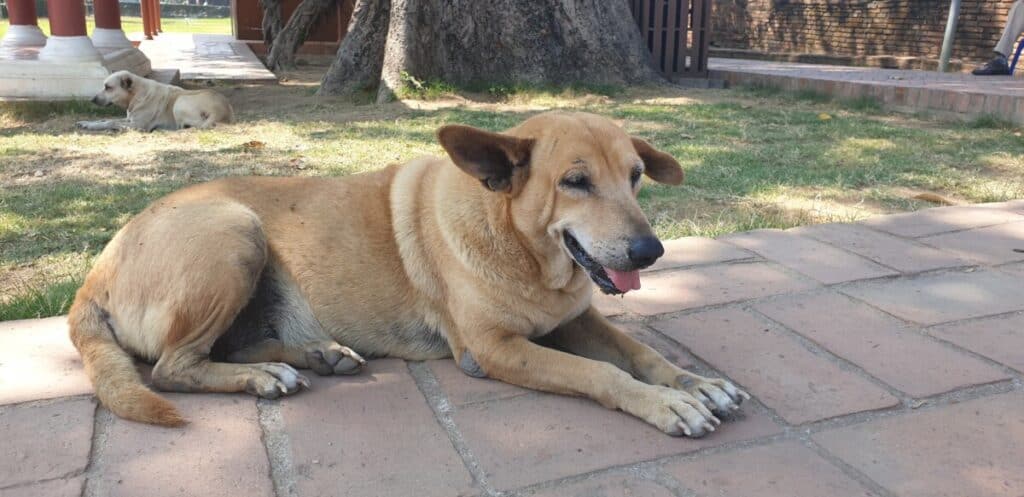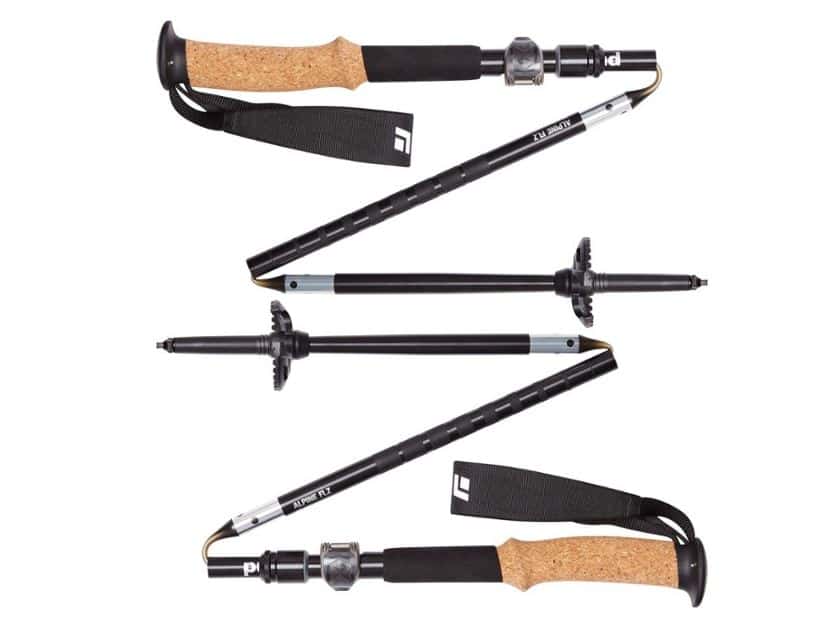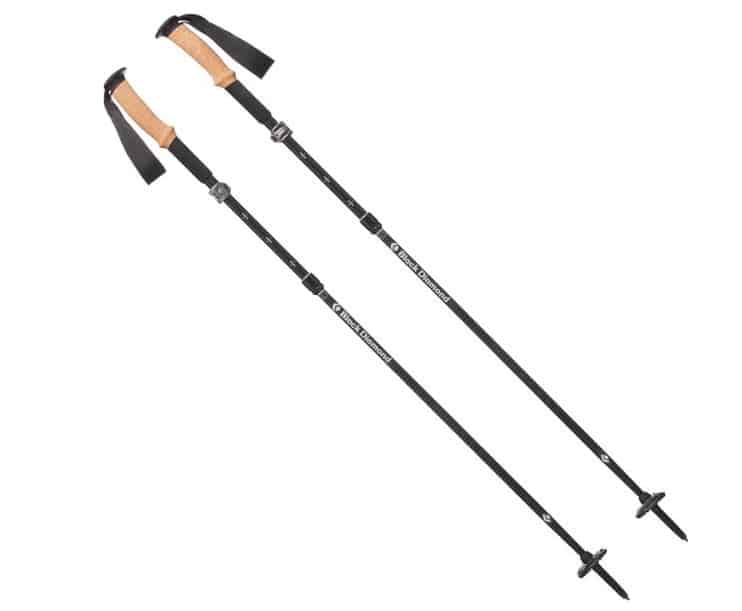Often hiking near cities I commonly come across stray dogs on the trails. This can also be more prevalent in some cities where packs of stray dogs roam the streets.
I have had tried experience dealing with stray dogs and combined with additional research and collated knowledge on forums, I have put together the very best way to protect you and your dog from stray dogs or street dogs.
The best way to protect your dog from stray dogs is to be calm, in control and confident. Move through the stray’s territory quickly without running. For escalated confrontations yell in a loud deep voice and make big arm movements. Carry a spray bottle, mace or stick to warn any dog getting too close.
To know how to best protect yourself and your pup you need to know a little about stray dogs and the different scenarios that can happen. We have outlined that good training of your own dog and strong leadership is vital for your dog to remain calm and for you to get respect from the surrounding stray dogs.
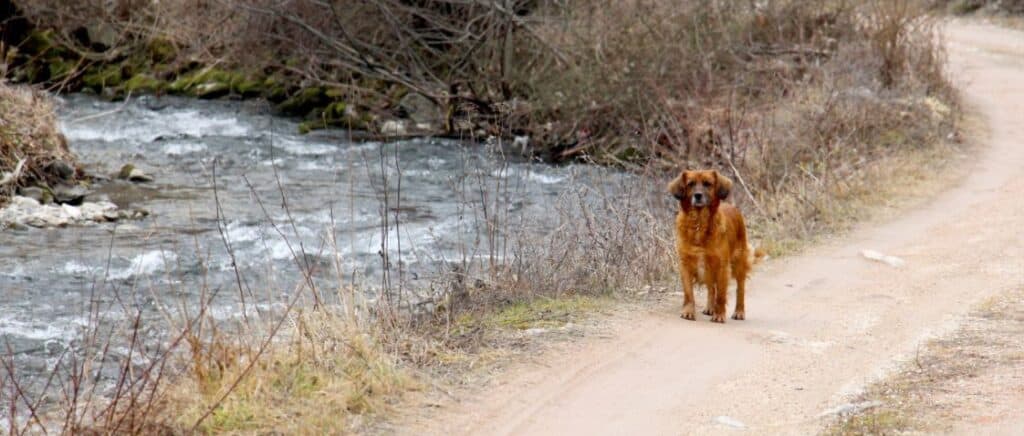
Information gathered from various forums have revealed some of the best items to carry and what items didn’t work so well when walking your dog.
Being confronted by stray dogs when you are out walking your dog can be a stressful and sometimes scary experience. Here are the dos and don’ts to follow
Do’s
- Do maintain a calm and confident demeanour
- Assess the situation and level of aggression by the stray dog – decide if the dog is being territorial, antagonising or attacking.
Don’ts
- Don’t panic
- Don’t let your dog lead you into space or be in front of you – have your dog by your side or behind you.
- Do NOT move backwards when the dog is barking in front of you. Move forwards and make the stray dog move backwards
- Never run away.
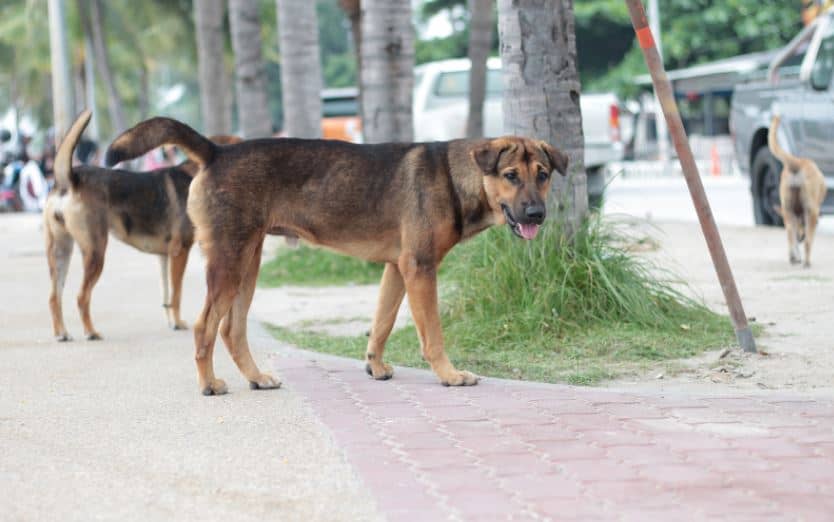
A Territorial dog
- Keep your dog by your side or behind you
- Don’t let your dog face head on with the stray dog.
- Make sure the stray dog approaches from the side.
- Confront the approaching dog and say ‘’Hey Back’’ and step into the stray dog’s space.
- Keep moving through the space, try to ignore the dogs.
- Keep moving the dog will likely stop following.
An Antagonizing Dog
- Identify the lead alpha dog or the antagonising dog in the pack.
- Keep an eye on the lead dogs location but do not stare directly into the dog’s eyes
- If the dog begins to nip at your dog continue the ‘’Hey Back’’ routine
- Face the dog and use big arm movements to tell it to go.
- Use improvised objects to maintain and build space between you and the pack like using a spray bottle or a stick.
- Do not move backwards as it will provoke them more to chase and nip
- Keep moving, the dog will likely stop following.
A Charging Attacking dog
- Quickly adopt an aggressive pose with arms out, knees bent and yell loudly at the dog to chase it away.
- As the dog gets closer use the spray bottle or whatever you have to maintain space between you and the dog
- The aim is to stop its charge and change its mindset from attacking.
- If you are being attacked hold your ground and stay on your feet at all costs.
- If you are with children, keep them safe by putting them up high in a tree or on top of a car.
How Leadership and calm assertive confidence is vital when confronted by street dogs
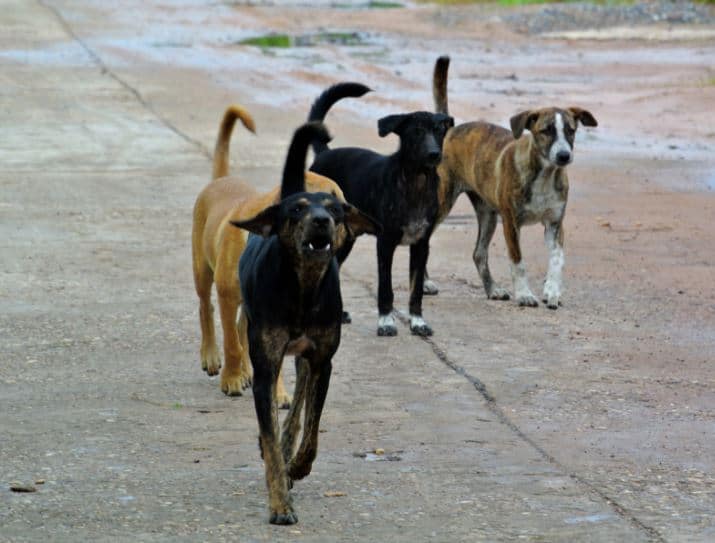
Maintaining calm-assertive leadership with your own dog will help to keep your dog calm during the encounter.
If you are not in a leadership role with your dog, your dog will take the role of leadership and protect you and may attack or bring on an attack with the stray dog.
This is not ideal as you want to move through the space as quickly as you can without any altercation. If your dog and a stray dog gets into a fight then you have a whole new set of problems. The last thing you want is for your dog to be injured during your walk.
Being the leader and showing confidence you are essentially telling your dog that it’s ok and I will protect you.
Also being confident in this situation, you are portraying energy that you are not to be messed with by the stray dogs.
Displaying confidence in a stressful situation is hard to do. You need to remember to breathe deeply and centre yourself with the situation. Controlled breathing is the best way to keep calm.
If you don’t control your breaking, you will likely panic and act out in fear or aggression which will only entice the stray dogs to engage and could lead to an attack.
If you don’t think you can display confidence then the best way to do this is to act it out or fake it. Even pretending to be confident works in these situations.
Watch how this policeman dog handler calmly walks with his dog while 9 or more stray dogs are antagonizing him and his dog.
- Notice how he is calm, not in a rush, walks slowly and keeps his eyes on the dogs.
- He holds his ground and doesn’t move backwards when the strays are in front of him.
- Also, notice how the black dog with the white back paws is leading this confrontation. This dog is the alpha dog in the stray pack. Watch how all the other dogs follow these alpha dogs movements.
- If you watch the policeman he has already identified this dog as the lead dog and he keeps an eye on this dog the most.
- He uses the end of the leash as a whip to maintain space between him and the strays if they get too close.
We will talk about improvised items to carry further down.
The most useful command to prevent a dog fight
I practise the “leave it” command whenever I want my dog to ignore something. This could be food and the ground, a cat, or even a barking dog. When I say the command my dog is not even allowed to look in the direction.
His ears have to be down and relaxed and he’s not to be pulling on the leash. Stopping him from even looking controls his state of mind and therefore he doesn’t want to engage.
If I say the command early enough he follows through. However, if I’m late with my command he has already adopted a dominant stance with ears pricked, tail high and hair up along his back. In this state, it’s harder for me to bring him back down to a relaxed demeanour.
So saying this command early is key to controlling your dog’s state of mind in a confronting situation.
Depending on the situation, a few quick pulls on the leash let him know to calm down and to snap out of a heightened state and the majority of the time he will obey.
This command has worked so many times when an antagonising dog is moving around us and I don’t want my dog to engage in an altercation. Once given the command my dog will ignore the barking stray dog.
The reason this command is so good is that it allows you to have full control of your dog and you can move out of the space as quickly as you can.
It’s harder to move out of a space with your dog, if your dog is pulling you to get into an altercation with the stray dog, preventing you both from leaving quickly.
The best items to carry when defending yourself against street dogs
If you are in an area where there are lots of stray dogs then having something with you to maintain the space between you and the stray dog can be very beneficial.
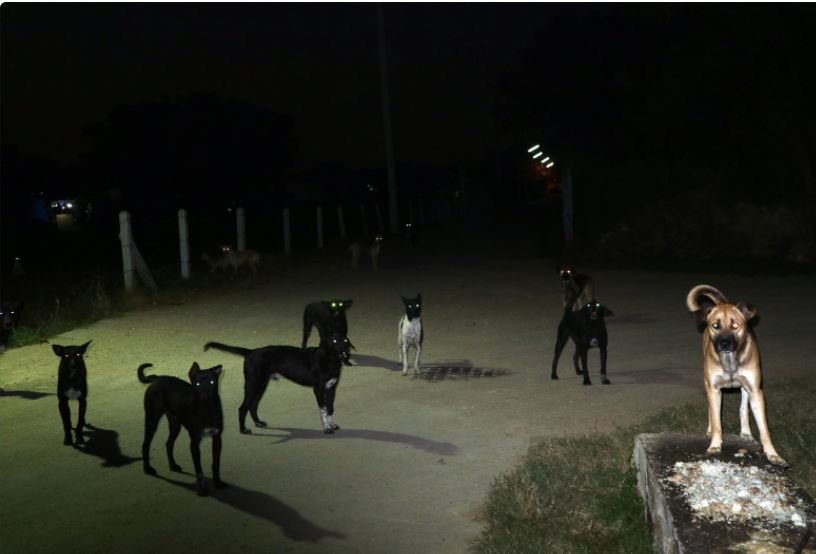
Best Proven Method – Water Spray Bottle
After doing lots of research on youtube videos and on forums the best item that has worked seems to be a water spray bottle. This is perfect as it can spray a jet of water a few meters ahead and seem to keep dogs at a distance. It startles the dogs as they weren’t expecting it and doesn’t hurt them.
These can be picked up in every city and some can even spray a jet of water more than just a few meters. Note that this will only work on a dog that is territorial barking or antagonising.
For a dog that is in an attack charge, this may not work.

A Stick or Trekking Poles to maintain distance on approaching stray dog
In the past, I have used my backpack to swing in front of an attacking dog but I don’t think this worked very well. Also, I can’t imagine doing this while trying to keep calm and controlling my own dog at the same time. This is also true for a large stick. Carrying a stick with you is fine if you are by yourself. But it is hard to control your dog while using a stick for protection.
Remember the aim is not to physically hit the stray dog. The stick is to be used to maintain space around you. You can do this by just pointing the stick in the dog’s direction or hitting the stick on the floor in front of the dog. This is telling the stray dogs that this is your space and not to cross it.
If you begin trying to hit the dogs with the stick you will only aggravate the stray dog which could lead to an attack. Refrain from doing this unless you are forced to.
The other issue with a stick is that you look intimidating walking down the street and you may not feel uncomfortable carrying a large stick in the street. One reader stated that they used a collapsible Hiking / Trekking pole. When they knew they were going in the area with the stray dogs they would assemble the hiking stick. When the threat had passed they would then collapse it and place it back in their backpack.
If you go hiking a lot, then invest in a good quality trekking pole that is strong and sturdy. This is vital for a collapsible pole as its locking mechanism needs to be of good design and quality material. The one that I use is the Black Diamond Alpine pole as it is strong and can be used on all terrains. See this link to obtain your own set.
Pepper Sprays or Gels
Pepper Spray is the best off the shelf method of protection. and this also will work well with an attacking dog. Pick a product that works as a stream or gel and less of a spray so you and your dog don’t get affected by the product in a windy outdoor environment.
As this product will cause severe irritation, this should only be used as a last resort when it’s likely that you will be attacked.
It’s relatively cheap and is easily accessible. Sabre Red Keychain Flip Top Pepper Spray and Pom Compact Pepper Spray are actually pepper streams that will work well in an outdoor environment for about 3 meters or 10 feet. This compact design fits easily in your pocket for fast access.
Check the rules and regulations of your area before purchasing.
Throwing Stones.
If you didn’t bring anything then throwing stones may be your last defence. This can work effectively to create distance and to help chase off any antagonising dogs.
Remember, anything that you can do with one hand to maintain distances while still keeping calm and in control of your dog with the other hand will work well.
The aim is to keep the distance so you can keep moving out of the territory of the stray dogs and they will likely leave you alone. Do your best to not provoke an attack and use physical ways of protection as a last resort.
At the start of an altercation a loud word like ‘’Hey’’, ”Go” and using strong-arm movements may be all that is needed for defence.
Watch how this little boy is confronted by dogs half his size on his bike and he decides to face the dogs and run at them. He also picks up some stones to throw at them to create space.
Other Improvised items
A Swinging bag – as mentioned, I did try the swing bag method and the reason I thought it didn’t work was that it became a game for the dog and activated its prey drive. With each swing, It didn’t really allow me to build space between the dog. The dog became fixated on the bag and wanted to just attack the bag.
A Belt – using my belt would have acted like the whip to gain space, the same way the policeman in the youtube clip was using the end of the leash.
Water bottle – a water bottle could work but only on timid dogs and won’t be as effective as a spray bottle
Identifying the various scenarios of street dog altercations
To first protect yourself from a stray dog or street dogs you need to understand the various scenarios of altercations of a stray dog.
A Lost Dog
If you see a dog on the trail or the streets, it may not be a stray, it might just be lost. It’s important to identify this quickly so you know what you are dealing with. A lost pet is unsure of its environment and will often befriend a stranger for guidance.
Typically a lost dog can be a known breed of dog as most strays or street dogs are mixes of breeds. Another sign that the dog is lost is that it is well-groomed, with a clean coat, trimmed nails etc. The dog also might have a collar on where you should be able to find its name and a number to call.
The behaviour of lost dogs can vary. They are unsure of their surroundings and often will ignore the dangers of approaching cars. Due to this can be erratic, hyperactive and running around or they might be scared and hiding.
Lost dogs should still be approached with caution and I’d advise against approaching a lost dog with your dog with you. As this may bring on altercations with your dog. It’s best to call a friend to help track down the owner.
A Territorial Dog – A Stray Dog Barking From a Far
If you are walking your dog and a stray dog is barking from a distance and not moving closer. This is an indication that you are on the outside edge of its territorial boundary. Often dogs can do this at fence lines where they won’t engage but they will bark and make sure that you have passed by.
In this situation, you can keep walking forward through the area.
A Territorial Dog / Antagonising Dog – Stray dogs Barking from a distance (on your side) moving closer to investigate you and your dog.
This is the most common scenario where a dog will bark continually from afar and move in closer barking from the sides of you. They often keep a 2 or 3m distance and will try to move behind you to sniff your dog.
Majority of the time the dog won’t attack and will continue barking following you out of its territory. So keep moving and don’t allow your dog to engage. These dogs move around you and barking, making lots of noise moving back and forth.
For this scenario, it’s better if the stray dog has approached you from the side. Where you can continually move forward where the dog will follow you barking. By ignoring the dog and walking with confidence, keep pulling your dog and try not to let your dog engage in eye contact with the stray dog.
Keep aware of the stray dog’s position behind you as you don’t want it to sneak up on you. Have your item ready in case the dog gets too close or starts antagonising you.
In this situation, you are moving through its territory quickly (without running) and using avoidance. The stray dog will follow you to a point and then return back to its territory.
A Territorial Dog / Antagonising Dog – Stray dogs barking from a distance (in front of you) and moving closer to investigate you and your dog.
This scenario is a little different from the scenario of the dog on the side. If you see a dog in the distance in front of you. You are possibly walking directly into the middle of its territory.
Also to note when two dogs are faced each other and staring directly into each other’s eyes while approaching it could lead to an attack. This is why it’s much safer if the stray dog approached you from the side.
Often a dog will pause, hold its ground and growl and give aggressive warning barks.
If you see this scenario playing out it’s best to pick an alternative route or walk around the space. Or if you are boarded from buildings on either side consider heading back for another route.
In this scenario, the dog is more likely to act in an antagonising way and be more confrontational with you and your dog.
Don’t walk directly to the stray dog and try to walk along the sides. Keep calm and take your time if you need to.
A Pack of Dogs
A pack of dogs can have the same patterns as mentioned above and will often have a leader within the pack. If you are confronted with a pack of dogs it’s important to work out quickly who is the alpha of the pack. This dog will normally be the one the others follow and maybe the dog that instigated the altercation with your dog.
Notice in the Youtube clip that the alpha dog was the black dog with white back paws. All the other dogs did what this dog did and followed his movements
A Charging Dog
If you see a dog running at you in charge, you only have a few moments to defend yourself and your dog.
If you own a small dog then picking up your dog will be your first reaction.
If you do pick up your dog, it’s guaranteed that the charging dog will jump up at you to get to your dog. You need to use your knee to defend yourself. For when the dog jumps at you, lift your knee into the chest of the dog. This will throw the dog back and off balance. Here you can step in and yell at the dog ‘‘back’’ or ‘’bad dog’’
Continually do this until you can call for help or place your dog on top of a car or ledge.
If you can’t pick up your dog, you need to confront the attacking dog with your presence. Move into the oncoming dog with the scream ‘’Back’’ with big arm movements. This might just be enough to stop the dog in a charge and it may keep its distance from you.
In both cases do not move backwards away from the dog. It will only provoke the dog more to attack you. By challenging the dog, the strays will likely leave you alone. You need to show dominance over the attacking dog.
What to do if a dog is attacking your dog.
If the dog has started a fight with your dog, this could be a very dangerous situation for you. If you are with children keep them safe at all costs and don’t engage with the fight. Place any child in a tree or on top of a car out of the dog’s reach. Before trying to break up the fight.
When an attack starts between two dogs, it starts sounding really bad with lots of growls and barks. Both dogs may be on their hind legs pushing each other but not biting. At this moment you could try and pull them apart quickly by grabbing them briefly to fling them back out of the way without holding on to them.
This is to create space between them and then you might be able to intercept the attacking dog. Or you might be able to grab the small dog and throw it over the other side of a fence.
This is ok for medium size dogs like a Staffie. But this won’t work for something as big as a rottweiler or mastiff and you are likely to get bitten by the attacking dog or even by your own dog trying to defend itself.
At this point, it’s best to stay calm
The dog fight will progress to the attacking dog biting down and hard on each other in a holding motion. Which they may then try to shake their heads back and forth.
If you are with another person you could try to both lift the dogs by the collar with both hands in a twist motion, which will cause tightening of the collar around the neck and will result in loss of blood flow to the brain and the dogs will eventually let go of each other or pass out.
This method works best with two people. Grabbing and even twisting the collar as you lift will cause the collar to tighten around the dog’s neck like a chokehold or sleeper hold.
If you are alone you may have to tie the other dog to something like a fence and then once tied you could use this method on the attacking dog. If the dog doesn’t have a collar then you can improvise with a leach or your belt.
See this method described by a city animal warden with many years of experience handling dogs.
This is the worst-case scenario, however, these full attacks can happen. This method of putting a chokehold on the dog is the safest way to make a dog let go.
A lot of people in the panic of the fight will hit the dog with objects and kick the dogs to make them let go, but this will only aggravate them further.
Always have a strong leather collar on your dog and a leash with you as you may have to improvise.
In Conclusion
Being surrounded by stray dogs when you are with your own dog can be a confrontational experience. Just remember to keep calm and maintain confidence. Address any antagonistic behaviour with your presence and carry your water spray bottle or any other item to maintain distance so you can keep moving out of the danger zone. Also, be sure that you and your dog receive the rabies vaccine just in case.
